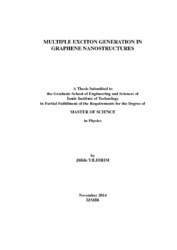Please use this identifier to cite or link to this item:
https://hdl.handle.net/11147/4281Full metadata record
| DC Field | Value | Language |
|---|---|---|
| dc.contributor.advisor | Çakır, Özgür | - |
| dc.contributor.author | Yıldırım, Jülide | - |
| dc.date.accessioned | 2015-05-08T08:22:43Z | |
| dc.date.available | 2015-05-08T08:22:43Z | |
| dc.date.issued | 2014 | - |
| dc.identifier.citation | Yıldırım, J. (2014). Multiple exciton generation in graphene nanostructures. Unpublished master's thesis, İzmir Institute of Technology, İzmir, Turkey | en_US |
| dc.identifier.uri | http://hdl.handle.net/11147/4281 | - |
| dc.description | Thesis (Master)--Izmir Institute of Technology, Physics, Izmir, 2014 | en_US |
| dc.description | Includes bibliographical references (leaves 37-40) | en_US |
| dc.description | Text in English; Abstract: Turkish and English | en_US |
| dc.description | vii, 44 leaves | en_US |
| dc.description.abstract | This thesis comprises a theoretical study on the role of the inverse-Auger process in graphene nanostructures. Inverse-Auger effect (IAE) is the formation of a multitude of low energy excitons from a single exciton of higher energy. Its mechanism is the conversion of the kinetic energy of the high energy carriers to new excitons via Coulomb interaction. Bulk graphene has zero band gap energy and has two Dirac points which is linearly dependent crystal momentum. Due to quantum confinement, graphene nanoribbons and graphene flakes or the structures having periodically holes develop a band gap. The emergence of a band gap makes these structures eligible for solar cell applications. In bulk structures, due to translational symmetry momentum is conserved which leads to a decreased IAE. However, in nanostructures, in addition to the relaxation of momentum conservation condition, the Coulomb interaction between the carriers increases which leads to an enhanced IAE. In this thesis, a theoretical analysis of inverse-Auger effect is carried out for graphene and armchair graphene nanoribbons. Tight binding method is employed to obtain the electronic structure and to calculate the Coulomb matrix elements for the inverse-Auger effect in this structures. According to our calculations, inverse- Auger effect in the bulk graphene provides the formation of new excitons at a rate which is approximately linearly proportional to the energy of an electron at the conduction band. | en_US |
| dc.language.iso | en | en_US |
| dc.publisher | Izmir Institute of Technology | en_US |
| dc.rights | info:eu-repo/semantics/openAccess | en_US |
| dc.subject | Semiconductor solar cell | en_US |
| dc.subject | Photoconductivity | en_US |
| dc.subject | Semiconductors | en_US |
| dc.title | Multiple exciton generation in graphene nanostructures | en_US |
| dc.title.alternative | Grafen Nano Yapılarda Çoklu Eksiton Oluşumu | en_US |
| dc.type | Master Thesis | en_US |
| dc.institutionauthor | Yıldırım, Jülide | - |
| dc.department | Thesis (Master)--İzmir Institute of Technology, Physics | en_US |
| dc.relation.publicationcategory | Tez | en_US |
| dc.identifier.wosquality | N/A | - |
| dc.identifier.scopusquality | N/A | - |
| item.openairecristype | http://purl.org/coar/resource_type/c_18cf | - |
| item.grantfulltext | open | - |
| item.fulltext | With Fulltext | - |
| item.cerifentitytype | Publications | - |
| item.openairetype | Master Thesis | - |
| item.languageiso639-1 | en | - |
| Appears in Collections: | Master Degree / Yüksek Lisans Tezleri | |
Files in This Item:
| File | Description | Size | Format | |
|---|---|---|---|---|
| T001304.pdf | MasterThesis | 890.7 kB | Adobe PDF |  View/Open |
CORE Recommender
Page view(s)
270
checked on Jul 7, 2025
Download(s)
176
checked on Jul 7, 2025
Google ScholarTM
Check
Items in GCRIS Repository are protected by copyright, with all rights reserved, unless otherwise indicated.